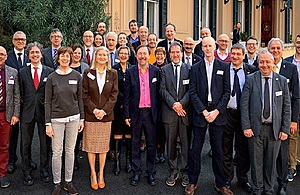Testing is now under way on automated cone laying vehicles being developed by Highways England and a group of industry experts.
Putting out cones is still currently undertaken by two people on the rear of a vehicle working in tandem. The bulk of this work is undertaken at night and carried out in most weathers with the workers lifting up to 10 tonnes of equipment per shift.
View the automated cone laying video
Cones are needed to protect road users and road workers while essential improvements or maintenance is carried out on the busy routes. But with motorway traffic thundering past, putting out the cones can be quite scary for workers.
The automated cone laying machines, which could be in use by the end of the year, will improve safety and free up two workers to carry out other tasks.
Two vehicles have been developed. The first, created by Highway Care, has been undergoing testing at the Bruntingthorpe site in Lutterworth, Leicestershire. The second, developed by competitor King Highway Products, is due to be trialled next month.
Highways England Head of Lean and Continuous Improvement Martin Bolt, who leads the project, said:
We are constantly looking for ways to improve safety for everyone who works and travels on our road network and have been delighted with the initial tests of this innovative vehicle.
The first tests have been very positive. We have already received a lot of interest and support from the industry, applauding an initiative which will take the human element out of putting cones and therefore take away an element of potential risk.
As well as taking away this physical and laborious task, these automated machines will also help us to redeploy the workforce to some of the many other traffic management duties.
Experts from Highways England, Kier, HW Martin Traffic Management and competitors Highway Care and King Highway Products are working together in a collaborative effort to resolve this potential safety risk.
Highways England are funding the development and establishment of a minimum standard while the companies themselves are developing the vehicles.
To date, ergonomics experts have struggled to identify a suitable method of placing and removing cones that doesn’t have an impact on workers due to the twisting of the body required or a vehicle that does not require any workers on the back.
It is hoped the automated cone laying vehicles will tackle this issue. Highways England criteria stipulates that not only must the machines offer a safer method for highways workers, they must be safe for all road users and pose no further risk to traffic.
The new cone laying vehicles must be able to lay/collect at least 400 cones at a rate of one every 10 seconds If the tests prove successful the two companies will be able to take their vehicles to the marketplace. It is hoped both machines – if they prove themselves in testing – will be implemented in late 2020.
General enquiries
Members of the public should contact the Highways England customer contact centre on 0300 123 5000.
Journalists should contact the Highways England press office on 0844 693 1448 and use the menu to speak to the most appropriate press officer.
